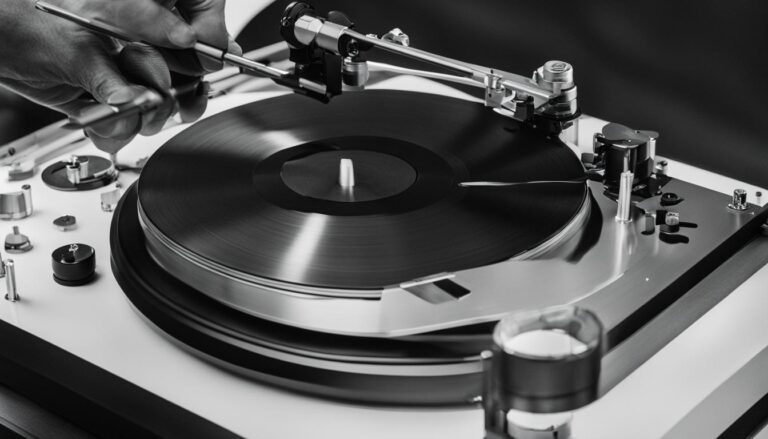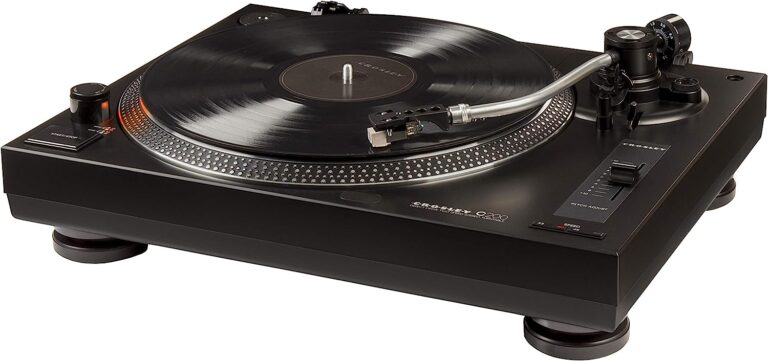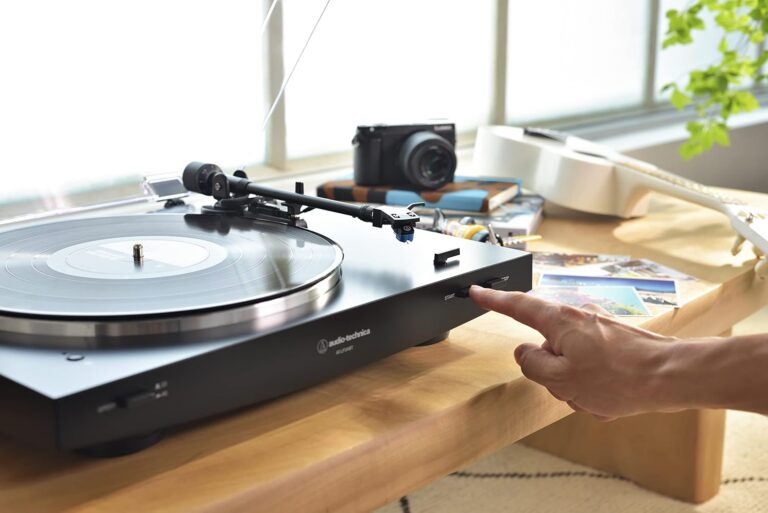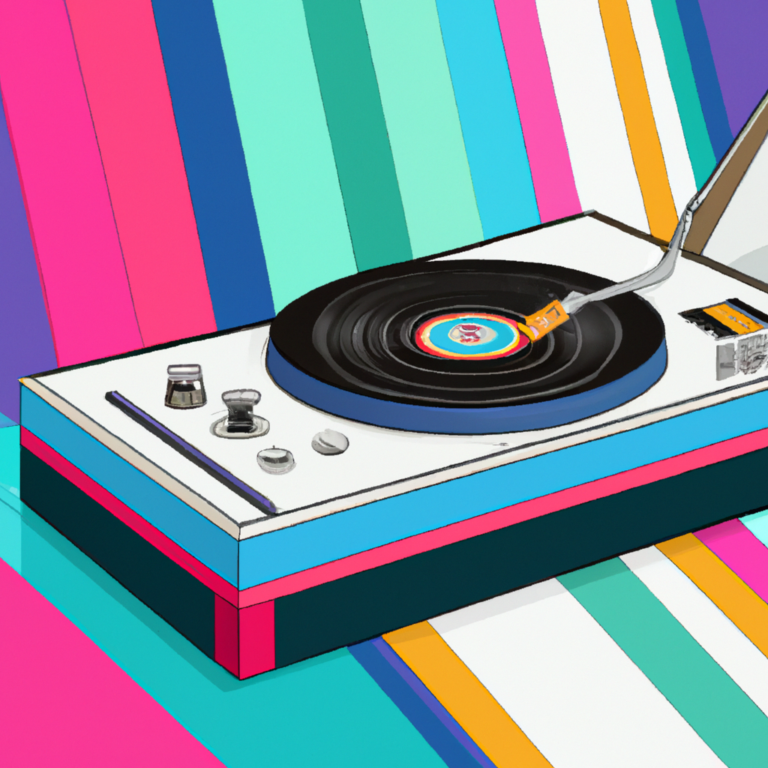Master Guide: How to Calibrate a Turntable Perfectly
Welcome to the ultimate guide on how to calibrate a turntable perfectly. Whether you’re a DJ, a vinyl enthusiast, or simply someone looking to enjoy the rich sound of your records, this guide has got you covered.
From turntable setup to cartridge alignment and tonearm adjustment, I’ll walk you through every step to ensure optimal performance and sound quality. So, let’s dive in and unlock the true potential of your turntable!
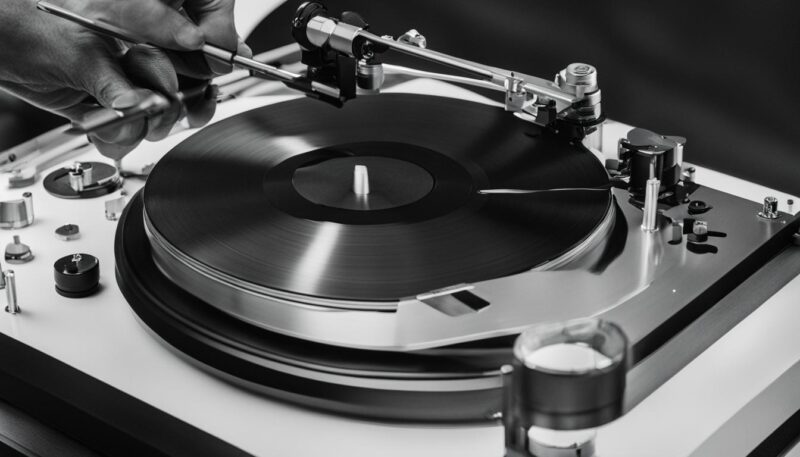
Key Takeaways:
- Understanding the importance of turntable calibration is crucial for achieving optimal sound quality.
- Proper turntable setup involves balancing the tonearm, adjusting the tracking force, and setting the anti-skating.
- Cartridge alignment using a protractor ensures accurate sound reproduction and reduces wear on your records.
- Speed calibration and tracking force adjustment play a significant role in preventing distortion and skipping.
- Regular maintenance, such as cleaning and stylus care, is essential for preserving your turntable and records.
How to Choose a Turntable
When it comes to choosing a turntable, there are several factors to consider that will impact your listening experience. First and foremost, you need to decide on the type of drive system. Direct-drive turntables are popular among DJs for their instant control over the spinning speed of the disc. On the other hand, belt-driven turntables are designed to reduce vibrations from the motor, resulting in a smoother and more accurate playback.
Next, you’ll need to consider the operation type of the turntable. Manual turntables require you to manually lift and place the tonearm onto the record and return it once the record finishes playing. Automatic turntables, on the other hand, can do this automatically with the push of a button.
Semi-automatic turntables offer a combination of manual and automatic operation, allowing you to start and stop the turntable manually while automatically lifting and returning the tonearm.
Another important feature to consider is the presence of a built-in preamplifier. A built-in preamplifier eliminates the need for an external preamp, making it easier to connect your turntable directly to powered speakers or a receiver.
Additionally, some turntables offer wireless options, allowing you to stream your vinyl records wirelessly to compatible speakers or headphones. If you’re looking to digitize your vinyl collection, you may also want to choose a turntable with a USB port for easy recording and transfer of your records to a digital format.
How to Choose a Turntable Summary:
- Consider the type of drive system (direct drive vs. belt-driven)
- Decide on the operation type (manual vs. automatic vs. semi-automatic)
- Check for a built-in preamplifier or wireless options
- Ensure compatibility with your sound system
- Check if the cartridge is replaceable for future upgrades
By considering these factors, you can choose a turntable that best suits your needs and preferences, allowing you to fully enjoy your vinyl records with exceptional sound quality.
How to Set Up a Turntable
Setting up a turntable properly is crucial for achieving optimal performance and audio quality. Here are the key steps to follow:
- Level the turntable: Place the turntable on a sturdy surface and use a level to ensure it is balanced horizontally.
- Balance the tonearm: Adjust the counterweight at the back of the tonearm until it is parallel to the platter. This ensures proper tracking and prevents excessive wear on your records.
- Adjust the counterweight: Set the tracking force by turning the counterweight. Consult your turntable’s manual or the cartridge manufacturer’s specifications to determine the correct tracking force for your cartridge.
- Set the anti-skating: Anti-skating prevents the tonearm from exerting too much force on one side of the groove. Adjust the anti-skating dial to match the tracking force you’ve set.
- Select the correct speed: Choose the appropriate speed for the record you’re playing. Most turntables have buttons or switches to toggle between 33 1/3, 45, and sometimes 78 RPM.
Following these steps will ensure that your turntable is properly set up and ready to deliver accurate sound reproduction.
It’s important to note that each turntable may have slight variations in the setup process, so always refer to the manufacturer’s instructions for specific guidance. Additionally, some turntables may feature additional settings, such as Vertical Tracking Angle (VTA) and stylus rake angle, which can affect the sound quality. If your turntable offers these adjustments, consult the manual for instructions on how to optimize them.
Remember to handle your turntable and records with care to avoid damage and ensure a long lifespan. Regular maintenance, such as cleaning the stylus and keeping the turntable clean, will also contribute to optimal performance and longevity.
Common Issues and Troubleshooting Tips
If you encounter any issues with your turntable setup, here are some common problems and solutions:
- Skipped or jumping records: Check the tracking force and anti-skating settings to ensure they are properly adjusted. Also, inspect the stylus for any dirt or debris that may be causing the skipping.
- Distorted sound: Incorrect tracking force or improper tonearm alignment can lead to distorted sound. Double-check the tracking force and consider aligning the cartridge using a protractor tool.
- Inconsistent speed: If your turntable’s speed fluctuates, the motor may need servicing or the belt may need replacing. Consult the manufacturer or a professional technician for assistance.
By following these setup steps and troubleshooting tips, you can ensure that your turntable is optimized for the best sound quality and enjoy your vinyl collection to its fullest.
How to Maintain a Turntable
Proper maintenance is crucial for keeping your turntable in optimal condition and preserving the quality of your vinyl records. Follow these essential tips to ensure your turntable stays clean, your records are protected, and your listening experience is top-notch.
Keep the Turntable Clean
Regular cleaning of your turntable is essential to remove dust, dirt, and debris that can affect sound quality and damage your records. Use a soft, lint-free cloth to gently wipe the surface of the turntable, including the platter and dust cover. Avoid using harsh chemicals or abrasive materials that can scratch or damage the delicate components.
Protect Records
To keep your records in pristine condition, store them vertically in a dust-free and temperature-controlled environment. Use inner record sleeves lined with anti-static plastic to protect against dust, fingerprints, and warping. Handle records with care, holding them by the edges and avoiding touching the playing surface to prevent oil and dirt transfer.
Clean the Stylus
The stylus, or needle, is a critical component that comes into direct contact with your records. Regularly clean the stylus with a soft brush designed specifically for this purpose. Gently brush the stylus from back to front, removing any accumulated dust or debris. Avoid applying excessive pressure, as this can damage the delicate stylus.
Replace the Belt and Stylus
Over time, the turntable belt may wear out or snap, affecting performance and speed accuracy. Check the condition of the belt regularly and replace it as needed. Similarly, the stylus will eventually degrade, leading to diminished sound quality and potential damage to your records. Consider replacing the stylus according to the manufacturer’s recommendations or if you notice signs of distortion or excessive wear.
When replacing the stylus, you have options in terms of stylus shapes. Different stylus shapes, such as spherical, elliptical, hyperelliptical, and micro-ridge, offer distinct sound characteristics. Experimenting with different shapes can help you find the one that best suits your listening preferences.
Types of Cartridges: Moving Magnet vs. Moving Coil
When considering cartridge upgrades, you may encounter two primary types: moving magnet (MM) and moving coil (MC). Both types have their own advantages and characteristics. Moving magnet cartridges are more common and typically offer a good balance between performance and affordability. Moving coil cartridges, on the other hand, are known for their superior sound quality, but they tend to be more expensive. Consider your budget and audio preferences when choosing between these two options.
Summary
Maintaining a turntable involves regularly cleaning the surface, protecting records from dust and damage, cleaning the stylus, and replacing the belt and stylus when necessary. By following these maintenance tips, you can ensure that your turntable and vinyl records deliver the best possible sound quality and last for years to come.
| Maintenance Tips | Turntable | Records | Stylus | Cartridge |
|---|---|---|---|---|
| Keep clean | Regularly wipe surface | Store vertically, use inner sleeves | Regularly clean with a soft brush | Depending on wear, replace as needed |
| Avoid harsh chemicals | Handle with care, avoid touching surface | Consider different stylus shapes | ||
| Choose between moving magnet and moving coil cartridges |
How to Calibrate a Turntable – True Audiophile’s Guide
Calibrating a turntable is an art that requires precision and attention to detail. In this True Audiophile’s Guide, I will walk you through the step-by-step process of calibrating your turntable to achieve the best sound quality possible. By following these instructions, you can elevate your listening experience to new heights.
Level Your Table
The first step in calibrating your turntable is to ensure that it is perfectly level. Use a bubble level to check the horizontal and vertical alignment, making adjustments as necessary. A perfectly leveled table will minimize any unwanted vibrations and provide a stable foundation for accurate playback.
Adjust Tracking Force
Tracking force refers to the downward pressure exerted by the stylus on the record. To calibrate this, balance the tonearm and zero out the tracking force gauge. Gradually add pressure until you achieve the optimal tracking force for your cartridge. This will prevent excessive wear on your records and ensure accurate playback.
Set Tangential Alignment Curve, Zenith, Speed, and More
In order to achieve precise tracking and minimize distortion, it’s crucial to set the tangential alignment curve, zenith, speed, vertical tracking angle, stylus rake angle, azimuth, and anti-skate. Each of these adjustments contributes to the overall accuracy and quality of your turntable’s performance.
Calibrating a turntable may seem daunting at first, but with careful attention to these settings and a keen ear, you can achieve an audio experience that truly showcases the capabilities of your vinyl collection. Take the time to calibrate your turntable properly, and you’ll be rewarded with a rich, detailed sound that will bring your favorite records to life.
| Calibration Step | Description |
|---|---|
| Level Your Table | Ensure your turntable is placed on a level surface to minimize vibrations. |
| Adjust Tracking Force | Balance the tonearm and set the optimal tracking force for your cartridge. |
| Set Tangential Alignment Curve | Find the best sound position for your favorite albums. |
| Set Zenith | Adjust the alignment of the needle for perfect playback. |
| Clock Your Speed | Select the correct speed for the record being played to avoid distortion. |
| Set Vertical Tracking Angle | Ensure the stylus is properly aligned with the record grooves. |
| Set Stylus Rake Angle | Adjust the angle of the stylus to optimize tracking performance. |
| Set Azimuth | Align the cartridge so that it is parallel to the record surface. |
| Set Anti-Skate | Ensure proper groove tracking and avoid distortion. |
Tips for Optimal Turntable Setup and Maintenance
Setting up and maintaining a turntable properly is crucial for optimizing sound quality and preserving your vinyl records. Follow these expert tips to ensure the best performance from your turntable and avoid any damage to your cherished records.
Turntable Setup Tips
- Place your turntable on a stable surface: A sturdy and level platform will prevent vibrations that can affect sound quality.
- Balance the tonearm: Ensure the tonearm is properly balanced to avoid excessive tracking force and potential damage to the stylus and records.
- Adjust the tracking force: Finding the optimal tracking force will help maintain proper groove tracking and reduce excessive wear on your records.
- Set the anti-skating: This adjustment helps keep the tonearm centered on the groove and prevents distortion.
- Choose the correct speed: Always select the appropriate speed for playing the record to avoid pitch variations and distortion.
Turntable Maintenance Tips
- Clean your records: Regularly clean your records using a carbon fiber brush or a record cleaning solution to remove dust and debris.
- Handle records with care: Always hold records by the edges and avoid touching the playing surface to prevent fingerprints and scratches.
- Protect records during storage: Store records vertically in protective inner sleeves to prevent warping and dust buildup.
- Clean the stylus: Use a stylus brush or cleaning solution to gently remove dirt and dust from the stylus tip to maintain optimum sound quality.
- Check and replace the belt: If your turntable uses a belt drive system, regularly inspect the belt for wear and replace it if necessary to ensure proper speed and performance.
Record Player Troubleshooting
If you encounter any issues with your turntable, here are some common troubleshooting steps:
- Check the setup: Ensure that all connections are secure and that the turntable is properly set up according to the manufacturer’s instructions.
- Clean the stylus: A dirty stylus can cause skipping or distorted sound. Clean it gently using a stylus brush or cleaning solution.
- Inspect the belt: If you notice speed inconsistencies or issues with playback, check the belt for any signs of wear or damage and replace if necessary.
- Check the cartridge: If you experience sound quality issues, inspect the cartridge for any visible damage or misalignment and consider replacing it if needed.
By following these tips for optimal turntable setup and maintenance, you can enjoy superior sound quality and prolong the life of your turntable and vinyl records.
FAQs
How do I choose a turntable?
When choosing a turntable, consider factors such as the drive system (direct drive vs. belt-driven), operation type (manual vs. automatic), built-in preamplifier, and wireless options. DJs often prefer direct-drive turntables for instant control, while belt-driven turntables reduce motor vibrations. The choice between manual and automatic operation depends on personal preference. It’s also important to check inputs and cables for compatibility and if the cartridge is replaceable for future upgrades.
What is the process of setting up a turntable?
To set up a turntable, start by placing it on a sturdy and level surface. Balance the tonearm by adjusting the counterweight and setting the anti-skating to match the tracking force used. Select the correct speed for the record being played to avoid distortion. Follow the manufacturer’s instructions and diagrams for proper setup and connect the turntable to your sound system using the appropriate cables.
How do I maintain a turntable?
Proper maintenance ensures the longevity and optimal performance of your turntable. Keep the turntable clean, store records vertically, and use anti-static inner sleeves to prevent dust, fingerprints, and warping. Handle records carefully and clean the stylus regularly. Replace the belt if it wears out or snaps, and consider replacing the stylus based on playtime and sound quality. Upgrading the cartridge can also enhance performance.
Can you provide a guide for calibrating a turntable?
True Audiophile provides a comprehensive guide for calibrating a turntable. It covers leveling the table, balancing the tonearm, adjusting the tracking force, setting the tangential alignment curve, adjusting the zenith, clocking the speed, setting the vertical tracking angle, stylus rake angle, azimuth, and setting the anti-skate for proper groove tracking and avoiding distortion.
What tips can you provide for optimal turntable setup and maintenance?
To optimize sound quality, keep the turntable on a stable surface, level it, and avoid external sources of vibration. Regularly clean and store records vertically to prevent damage. Take proper care of the stylus using an anti-static brush and clean it regularly. Troubleshoot common issues and periodically check for firmware updates or service bulletins from the manufacturer.
Conclusion
Calibrating a turntable is of utmost importance to enjoy optimal sound quality and protect your vinyl records. By following the proper setup and maintenance procedures, you can enhance your listening experience and prolong the life of your turntable and records.
Take the time to level your table, balance the tonearm, adjust the tracking force, and set the anti-skating. These steps ensure that your turntable operates at its best and minimizes any potential damage to your precious vinyl collection.
Expert tips for turntable calibration include regular cleaning and stylus care. Maintaining a clean stylus and using anti-static brushes can significantly improve the audio quality and prevent unnecessary wear and tear on your records.
Whether you’re a casual listener or a dedicated audiophile, mastering the calibration process allows you to fully appreciate the richness and depth of the vinyl sound. So, go ahead and dive into the world of turntables, and discover the magical experience of vinyl in its truest form.
Our Mission: At AudioInspects, we are dedicated to providing the most comprehensive and authentic reviews of audio equipment on the market. We conduct independent testing and research of products, so you can make an informed decision before making a purchase. Our mission is to help you find the best audio equipment to improve your listening experience. So trust us to deliver the most reliable recommendations and advice.
Disclosure: When you do decide to make a purchase through our links, please note that we may earn a commission, but this does not affect the honesty of our reviews. You can read our affiliate disclosure in our Disclosure.

